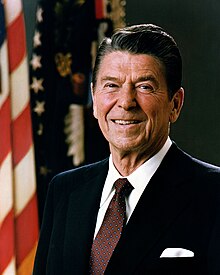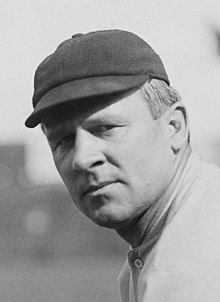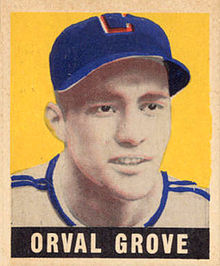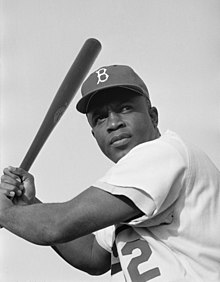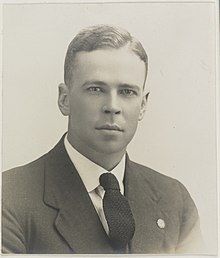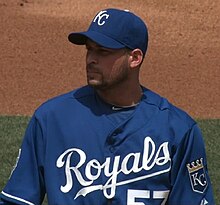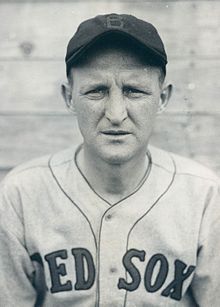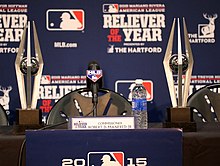Portal:Baseball
Portal maintenance status: (June 2018)
|
| Main page | Content, Categories & Topics | WikiProjects & Things you can do |
The Baseball Portal
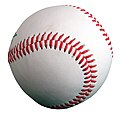
Baseball is a bat-and-ball sport played between two teams of nine players each, taking turns batting and fielding. The game occurs over the course of several plays, with each play generally beginning when a player on the fielding team, called the pitcher, throws a ball that a player on the batting team, called the batter, tries to hit with a bat. The objective of the offensive team (batting team) is to hit the ball into the field of play, away from the other team's players, allowing its players to run the bases, having them advance counter-clockwise around four bases to score what are called "runs". The objective of the defensive team (referred to as the fielding team) is to prevent batters from becoming runners, and to prevent runners advancing around the bases. A run is scored when a runner legally advances around the bases in order and touches home plate (the place where the player started as a batter).
The opposing teams switch back and forth between batting and fielding; the batting team's turn to bat is over once the fielding team records three outs. One turn batting for each team constitutes an inning. A game is usually composed of nine innings, and the team with the greater number of runs at the end of the game wins. Most games end after the ninth inning, but if scores are tied at that point, extra innings are usually played. Baseball has no game clock, though some competitions feature pace-of-play regulations such as the pitch clock to shorten game time.
Baseball evolved from older bat-and-ball games already being played in England by the mid-18th century. This game was brought by immigrants to North America, where the modern version developed. Baseball's American origins, as well as its reputation as a source of escapism during troubled points in American history such as the American Civil War and the Great Depression, have led the sport to receive the moniker of "America's Pastime"; since the late 19th century, it has been unofficially recognized as the national sport of the United States, though in modern times is considered less popular than other sports, such as American football. In addition to North America, baseball spread throughout the rest of the Americas and the Asia–Pacific in the 19th and 20th centuries, and is now considered the most popular sport in parts of Central and South America, the Caribbean, and East Asia, particularly in Japan, South Korea, and Taiwan. (Full article...)
 Featured articles - load new batch
Featured articles - load new batch
-
Image 1William Derrick Bates (born December 7, 1963) is an American former professional baseball second baseman and pinch runner who played in Major League Baseball (MLB) for the Milwaukee Brewers and the Cincinnati Reds. In 29 career games, Bates had a batting average of .125 with six hits, two runs batted in (RBI), 11 runs, and eight stolen bases. Though his defensive position was at second base, the Reds primarily used Bates as a pinch runner. After he scored the winning run in Game 2 of the 1990 World Series, Bates never played in MLB again.
Born in Houston, Bates attended the University of Texas and, in his freshman season, won the 1983 College World Series as a part of the Texas Longhorns baseball team. For the next two seasons, Bates was named to the College Baseball All-America Team, a team composed of the best collegiate baseball athletes in America. Drafted by Milwaukee in the fourth round of the 1985 MLB draft, he rose through the Brewers' farm system helping several of his minor league teams win their respective league titles. He made his MLB debut in 1989, after Milwaukee's starting second baseman Jim Gantner was injured. A trade in 1990 sent Bates to Cincinnati, where the Reds used him primarily as a pinch runner at the end of the regular season and into the postseason. Facing the Oakland Athletics in the World Series, Bates reached base on a pinch hit single against Dennis Eckersley and later scored the winning run in Game 2 as the Reds swept the Athletics four games to none. Following the World Series championship, the Reds re-signed Bates on a one-year contract, and he played for their Triple-A team. He spent the next year with the Chicago Cubs Triple-A affiliate, and last played exhibition baseball in 1995. After retiring, he worked as an equipment supplier in the oil and gas industry in Houston. (Full article...) -
Image 2
Derek Sanderson Jeter (/ˈdʒiːtər/ JEE-tər; born June 26, 1974), nicknamed "the Captain", is an American former professional baseball shortstop, businessman, and baseball executive. As a player, Jeter spent his entire 20-year Major League Baseball (MLB) career with the New York Yankees. He was elected to the Baseball Hall of Fame in his first year of eligibility in 2020; he received 396 of 397 possible votes, the second-highest percentage in MLB history (behind only teammate Mariano Rivera) and the highest by a position player. He was the chief executive officer (CEO) and part owner of the league's Miami Marlins from September 2017 to February 2022.
A five-time World Series champion with the Yankees, Jeter is regarded as a central contributor to the franchise's dynasty during the late 1990s and early 2000s for his hitting, base-running, fielding, and leadership. He is the Yankees' all-time career leader in hits (3,465), doubles (544), games played (2,747), stolen bases (358), times on base (4,716), plate appearances (12,602) and at bats (11,195). His accolades include 14 All-Star selections, five Gold Glove Awards, five Silver Slugger Awards, two Hank Aaron Awards, and a 2009 Roberto Clemente Award. Jeter was the 28th player to reach 3,000 hits and finished his career ranked sixth in MLB history in career hits and first among shortstops. In 2017, the Yankees retired his uniform number 2. (Full article...) -
Image 3
Robert William Meusel (July 19, 1896 – November 28, 1977) was an American baseball left and right fielder who played in Major League Baseball (MLB) for eleven seasons from 1920 through 1930, all but the last for the New York Yankees. He was best known as a member of the Yankees' championship teams of the 1920s, nicknamed "Murderers' Row", during which time the team won its first six American League (AL) pennants and first three World Series titles.
Meusel, noted for his strong outfield throwing arm, batted fifth behind Baseball Hall of Famers Babe Ruth and Lou Gehrig. In 1925, he became the second Yankee, after Ruth, to lead the AL in home runs (33), runs batted in (138) and extra base hits (79). Nicknamed "Long Bob" because of his 6-foot, 3 inch (1.91 m) stature, Meusel batted .313 or better in seven of his first eight seasons, finishing with a .309 career average; his 1,009 RBI during the 1920s were the fourth most by any major leaguer, and trailed only Harry Heilmann's total of 1,131 among AL right-handed hitters. Meusel ended his career in 1930 with the Cincinnati Reds. He hit for the cycle three times, and was the second of six major leaguers to accomplish this feat as many as three times during a career. (Full article...) -
Image 4
Ronald Wilson Reagan (February 6, 1911 – June 5, 2004) was an American politician and actor who served as the 40th president of the United States from 1981 to 1989. He was a member of the Republican Party and became an important figure in the American conservative movement. His presidency is known as the Reagan era.
Born in Illinois, Reagan graduated from Eureka College in 1932 and was hired the next year as a sports broadcaster in Iowa. In 1937, he moved to California where he became a well-known film actor. During his acting career, Reagan was president of the Screen Actors Guild twice, from 1947 to 1952 and from 1959 to 1960. In the 1950s, he hosted General Electric Theater and worked as a motivational speaker for General Electric. Reagan's "A Time for Choosing" speech during the 1964 presidential election launched his rise as a leading conservative figure. After being elected governor of California in 1966, he raised state taxes, turned the state budget deficit into a surplus and implemented harsh crackdowns on university protests. Following his loss to Gerald Ford in the 1976 Republican Party presidential primaries, Reagan won the Republican Party's nomination and then a landslide victory over President Jimmy Carter in the 1980 presidential election. (Full article...) -
Image 5
John Joseph McGraw (April 7, 1873 – February 25, 1934) was an American Major League Baseball (MLB) player and manager who was for almost thirty years manager of the New York Giants. He was also the third baseman of the pennant-winning 1890s Baltimore Orioles teams, noted for their innovative, aggressive play.
McGraw was born into poverty in Truxton, New York. He found an escape from his hometown and a bad family situation through baseball, beginning a quick rise through the minor leagues that led him to the Orioles at the age of 18. Under the tutelage of manager Ned Hanlon, the Orioles of the 1890s won three National League (NL) pennants; McGraw was one of the stalwarts of the team alongside Wee Willie Keeler, Hughie Jennings, and Wilbert Robinson. The Orioles perfected the hit and run play and popularized the Baltimore chop; they also sought to win by intimidating the opposing team and the umpire. (Full article...) -
Image 6
Morris Berg (March 2, 1902 – May 29, 1972) was an American professional baseball catcher and coach in Major League Baseball who later served as a spy for the Office of Strategic Services during World War II. He played 15 seasons in the major leagues, almost entirely for four American League teams, though he was never more than an average player and was better known for being "the brainiest guy in baseball." Casey Stengel once described Berg as "the strangest man ever to play baseball."
Berg was a graduate of Princeton University and Columbia Law School, spoke several languages, and regularly read ten newspapers a day. His reputation as an intellectual was fueled by his successful appearances as a contestant on the radio quiz show Information Please, in which he answered questions about the etymology of words and names from Greek and Latin, historical events in Europe and the Far East, and ongoing international conferences. (Full article...) -
Image 7Disco Demolition Night was a Major League Baseball (MLB) promotion on Thursday, July 12, 1979, at Comiskey Park in Chicago, Illinois, that ended in a riot. At the climax of the event, a crate filled with disco records was blown up on the field between games of the twi-night doubleheader between the Chicago White Sox and the Detroit Tigers. Many had come to see the explosion rather than the games and rushed onto the field after the detonation. The playing field was so damaged by the explosion and by the rioters that the White Sox were required to forfeit the second game to the Tigers.
In the late 1970s, dance-oriented disco was the most popular music genre in the United States, particularly after being featured in hit films such as Saturday Night Fever (1977). However, disco sparked a major backlash from rock music fans—an opposition prominent enough that the White Sox, seeking to fill seats at Comiskey Park during a lackluster season, engaged Chicago shock jock and anti-disco campaigner Steve Dahl for the promotion at the July 12 doubleheader. Dahl's sponsoring radio station was WLUP (97.9 FM, now WCKL), so admission was discounted to 98 cents for attendees who turned in a disco record; between games, Dahl was to destroy the collected vinyl in an explosion. (Full article...) -
Image 8Paschal before a game during the 1925 New York Yankees season
Benjamin Edwin Paschal (October 13, 1895 – November 10, 1974) was an American baseball outfielder who played eight seasons in Major League Baseball from 1915 to 1929, mostly for the New York Yankees. After two "cup of coffee" stints with the Cleveland Indians in 1915 and the Boston Red Sox in 1920, Paschal spent most of his career as the fourth outfielder and right-handed pinch hitter of the Yankees' Murderers' Row championship teams of the late 1920s. Paschal is best known for hitting .360 in the 1925 season while standing in for Babe Ruth, who missed the first 40 games with a stomach ailment.
During his time in baseball, Paschal was described as a five-tool player who excelled at running, throwing, fielding, hitting for average, and power. However, his playing time with the Yankees was limited because they already had future Baseball Hall of Famers Ruth and Earle Combs, and star Bob Meusel, in the outfield. Paschal was considered one of the best bench players in baseball during his time with the Yankees, and sportswriters wrote how he would have started for most other teams in the American League. He was one of the best pinch hitters in the game during the period, at a time when the term was still relatively new to baseball. (Full article...) -
Image 9
Orval Leroy Grove (August 29, 1919 – April 20, 1992) was an American professional baseball pitcher in Major League Baseball who played for ten seasons in the American League with the Chicago White Sox. In 207 career games, Grove pitched 1,176 innings and posted a win–loss record of 63–73, with 66 complete games, 11 shutouts, and a 3.78 earned run average (ERA).
The only freshman on the Proviso Township High School varsity baseball team, Grove's pitching ability attracted the attention of the White Sox. After signing with the team in 1937, Grove moved between the major leagues and minor leagues for a few seasons until 1943, when he found a solid place in the White Sox's pitching rotation. Grove had a career-year in 1943, finishing the season with career-bests in ERA, wins, and complete games; in 1944, he made his only All-Star appearance. (Full article...) -
Image 10Adenhart pitching for the Salt Lake Bees in 2008
Nicholas James Adenhart (August 24, 1986 – April 9, 2009) was an American right-handed baseball starting pitcher who played parts of two seasons in Major League Baseball (MLB) for the Los Angeles Angels of Anaheim. In just four career games, Adenhart pitched 18 innings and posted a win-loss record of 1–0.
A graduate of Williamsport High School, Adenhart was highly touted as a high school prospect until an injury in his final game required Tommy John surgery. The Angels drafted him in the 14th round of the 2004 Major League Baseball draft, and began playing in their minor league system after the surgery was a success. He spent three full seasons in the minor leagues before making his major league debut on May 1, 2008. After appearing in three games, Adenhart spent the rest of 2008 in the minor leagues developing his skills, and in 2009 he earned a spot in the Angels' starting rotation. (Full article...) -
Image 11Michael Lee Capel (born October 13, 1961) is an American professional baseball pitcher who played in Major League Baseball (MLB) for the Chicago Cubs, the Milwaukee Brewers, and the Houston Astros. In 49 career games, Capel pitched 62+1⁄3 innings, struck out 43 batters, and had a career win–loss record of 3–4 with a 4.62 earned run average (ERA). While he played in MLB, Capel stood at 6 feet 1 inch (185 cm) and weighed 175 pounds (79 kg). A starting pitcher in college and parts of his Minor League Baseball career, he converted to relief pitching while in Chicago's minor league system.
The Philadelphia Phillies chose Capel in the 24th round of the 1980 MLB draft, but the 18-year-old did not sign with the team; instead, he opted to attend the University of Texas. Capel played on the 1982 USA College All-Star Team, which competed in the Amateur World Series in Seoul and placed third. The next year, Capel and the Texas Longhorns won the College World Series. After he was drafted by the Cubs, Capel left Texas and signed to play professional baseball; he played in six seasons of Minor League Baseball before he made his MLB debut in 1988. Capel spent the entire 1989 season in Triple-A, one level below the majors, but the Cubs released him at the end of the year. He agreed to terms with the Brewers and played in MLB after an injury opened a spot on Milwaukee's roster, but was again released at the end of the season. A free agent, the Astros signed Capel, and over the course of the season he pitched in 25 games for the team. He spent the final part of his career in the Astros farm system, and after he made the 1992 Triple-A All-Star team, Capel played his last season in 1993. After retirement, Capel worked as the general manager of a car dealership in Houston, Texas. (Full article...) -
Image 12
Jack Roosevelt Robinson (January 31, 1919 – October 24, 1972) was an American professional baseball player who became the first African-American to play in Major League Baseball (MLB) in the modern era. Robinson broke the color line when he started at first base for the Brooklyn Dodgers on April 15, 1947. The Dodgers signing Robinson heralded the end of racial segregation in professional baseball, which had relegated black players to the Negro leagues since the 1880s.
Born in Cairo, Georgia, Robinson was raised in Pasadena, California. A four-sport student athlete at Pasadena Junior College and the University of California, Los Angeles, he was better known for football than he was for baseball, becoming a star college player with the UCLA Bruins football team. Following his college career, Robinson was drafted for service during World War II but was court-martialed for refusing to sit at the back of a segregated Army bus, eventually being honorably discharged. Afterwards, he signed with the Kansas City Monarchs of the Negro leagues, where he caught the eye of Branch Rickey, general manager of the Brooklyn Dodgers, who thought he would be the perfect candidate for breaking the color line in MLB. (Full article...) -
Image 13Los Angeles Angels center fielder Mike Trout hits a home run on a pitch from New York Mets pitcher Tommy Milone on May 21, 2017.
Baseball is a bat-and-ball sport played between two teams of nine players each, taking turns batting and fielding. The game occurs over the course of several plays, with each play generally beginning when a player on the fielding team, called the pitcher, throws a ball that a player on the batting team, called the batter, tries to hit with a bat. The objective of the offensive team (batting team) is to hit the ball into the field of play, away from the other team's players, allowing its players to run the bases, having them advance counter-clockwise around four bases to score what are called "runs". The objective of the defensive team (referred to as the fielding team) is to prevent batters from becoming runners, and to prevent runners advancing around the bases. A run is scored when a runner legally advances around the bases in order and touches home plate (the place where the player started as a batter).
The initial objective of the batting team is to have a player reach first base safely; this generally occurs either when the batter hits the ball and reaches first base before an opponent retrieves the ball and touches the base, or when the pitcher persists in throwing the ball out of the batter's reach. Players on the batting team who reach first base without being called "out" can attempt to advance to subsequent bases as a runner, either immediately or during teammates' turns batting. The fielding team tries to prevent runs by using the ball to get batters or runners "out", which forces them out of the field of play. The pitcher can get the batter out by throwing three pitches which result in strikes, while fielders can get the batter out by catching a batted ball before it touches the ground, and can get a runner out by tagging them with the ball while the runner is not touching a base. (Full article...) -
Image 14

Hershiser pitching for the Dodgers in 1993
During the 1988 Major League Baseball season, pitcher Orel Hershiser of the Los Angeles Dodgers set the MLB record for consecutive scoreless innings pitched. Over 59 consecutive innings, opposing hitters did not score a run against Hershiser. During the streak, he averted numerous high-risk scoring situations. The streak spanned from the sixth inning of an August 30 game against the Montreal Expos to the 10th inning of a September 28 game against the San Diego Padres. The previous record of 58+2⁄3 innings was set by former Dodger pitcher Don Drysdale in 1968; as the team's radio announcer, Drysdale called Hershiser's streak as he pursued the new record. Pundits have described the streak as among the greatest records in baseball history, with one pundit ranking it among the greatest individual feats in American sports.
During the streak, the Elias Sports Bureau changed its criteria for the official consecutive scoreless innings record for starting pitchers from including fractional innings in which one or two outs had been recorded to counting only complete scoreless innings. Since the streak was active at the end of the 1988 season, it could have spanned two separate seasons. However, Hershiser yielded a run in his first inning of work in the 1989 season against the Cincinnati Reds, thus ending the streak at 59 consecutive scoreless innings pitched. The streak includes only innings pitched in the regular season, excluding eight scoreless innings Hershiser pitched to start Game 1 of the 1988 National League Championship Series on October 4 (unofficially extending his streak to 67 combined innings). Although he completed the ninth inning in each start, the streak's final game lasted 16 innings, of which he pitched only the first 10. Thus, Hershiser did not match Drysdale's record of six consecutive complete game shutouts. Like Drysdale's streak, the penultimate game of Hershiser's streak was a Dodgers–Giants game that featured a controversial umpire's ruling that saved the streak. (Full article...) -
Image 15
William Harold Ponsford MBE (19 October 1900 – 6 April 1991) was an Australian cricketer. Usually playing as an opening batsman, he formed a successful and long-lived partnership opening the batting for Victoria and Australia with Bill Woodfull, his friend and state and national captain. Ponsford is the only player to twice break the world record for the highest individual score in first-class cricket; Ponsford and Brian Lara are the only cricketers to twice score 400 runs in an innings. Ponsford holds the Australian record for a partnership in Test cricket, set in 1934 in combination with Don Bradman (451 for 2nd wicket)—the man who broke many of Ponsford's other individual records. In fact, he along with Bradman set the record for the highest partnership ever for any wicket in Test cricket history when playing on away soil (451 runs for the second wicket)
Despite being heavily built, Ponsford was quick on his feet and renowned as one of the finest ever players of spin bowling. His bat, much heavier than the norm and nicknamed "Big Bertha", allowed him to drive powerfully and he possessed a strong cut shot. However, critics questioned his ability against fast bowling, and the hostile short-pitched English bowling in the Bodyline series of 1932–33 was a contributing factor in his early retirement from cricket a year and a half later. Ponsford also represented his state and country in baseball, and credited the sport with improving his cricketing skills. (Full article...)
General images - load new batch
-
Image 1In May 2010, the Philadelphia Phillies' Roy Halladay pitched the 20th major league perfect game. That October, he pitched only the second no-hitter in MLB postseason history. (from History of baseball)
-
Image 2Pick-off attempt on runner (in red) at first base (from Baseball rules)
-
Image 31906 World Series, infielders playing "in" for the expected bunt and the possible play at the plate with the bases loaded (from Baseball rules)
-
Image 4A game from the Cantigas de Santa Maria, c. 1280, involving tossing a ball, hitting it with a stick and competing with others to catch it (from History of baseball)
-
Image 5Diagram of a baseball field Diamond may refer to the square area defined by the four bases or to the entire playing field. The dimensions given are for professional and professional-style games. Children often play on smaller fields. (from Baseball)
-
Image 6The American Tobacco Company's line of baseball cards featured shortstop Honus Wagner of the Pittsburgh Pirates from 1909 to 1911. In 2007, the card shown here sold for $2.8 million. (from Baseball)
-
Image 7Sadaharu Oh managing the Japan national team in the 2006 World Baseball Classic. Playing for the Central League's Yomiuri Giants (1959–80), Oh set the professional world record for home runs. (from Baseball)
-
Image 8The strike zone determines the result of most pitches, and varies in vertical length for each batter. (from Baseball)
-
Image 9Sadaharu Oh managing the Japan national team in the 2006 World Baseball Classic. Playing for the Central League's Yomiuri Giants (1959–80), Oh set the professional world record for home runs with 868. (from History of baseball)
-
Image 10The NL champion New York Giants baseball team, 1913. Fred Merkle, sixth in line, had committed a baserunning gaffe in a crucial 1908 game that became famous as Merkle's Boner. (from History of baseball)
-
Image 12A first baseman receives a pickoff throw, as the runner dives back to first base. (from Baseball)
-
Image 13A well-worn baseball (from Baseball)
-
Image 14Cy Young—the holder of many major league career marks, including wins and innings pitched, as well as losses—in 1908. MLB's annual awards for the best pitcher in each league are named for Young. (from Baseball)
-
Image 15Rickey Henderson—the major leagues' all-time leader in runs and stolen bases—stealing third base in a 1988 game (from Baseball)
-
Image 16A pitcher handing off the ball after being taken out of the game during a mound meeting. (from Baseball)
-
Image 19Baseball games sometimes end in a walk-off home run, with the batting team usually gathering at home plate to celebrate the scoring of the winning run(s). (from Baseball rules)
-
Image 20Two players on the baseball team of Tokyo, Japan's Waseda University in 1921 (from Baseball)
-
Image 21Jackie Robinson in 1945, with the era's Kansas City Royals, a barnstorming squad associated with the Negro American League's Kansas City Monarchs (from History of baseball)
-
Image 23The typical motion of a right-handed pitcher (from Baseball rules)
-
Image 24The standard fielding positions (from Baseball rules)
-
Image 25Fenway Park, home of the Boston Red Sox. The Green Monster is visible beyond the playing field on the left. (from Baseball)
-
Image 28Japanese-Americans spectating a World War II-era game while in an internment camp. America's ties to immigrants and to Japan have been deeply shaped by a shared baseball heritage. (from History of baseball)
-
Image 29A New York Yankees batter (Andruw Jones) and a Boston Red Sox catcher at Fenway Park (from Baseball)
-
Image 30Jackie Robinson in 1945, with the era's Kansas City Royals, a barnstorming squad associated with the Negro American League's Kansas City Monarchs (from Baseball)
-
Image 32Cover of Official Base Ball Rules, 1921 edition, used by the American League and National League (from Baseball rules)
-
Image 33A runner sliding into home plate and scoring. (from Baseball)
-
Image 34Pesäpallo, a Finnish variation of baseball, was invented by Lauri "Tahko" Pihkala in the 1920s, and after that, it has changed with the times and grown in popularity. Picture of Pesäpallo match in 1958 in Jyväskylä, Finland. (from Baseball)
-
Image 35Alexander Cartwright, father of modern baseball (from History of baseball)
-
Image 36Baserunners generally stand a short distance away from their base between pitches, preparing themselves to either go back or steal the next base. (from Baseball rules)
-
Image 37Pitchers are generally substituted during mound visits (team gatherings at the pitcher's mound). (from Baseball rules)
-
Image 38By the 1860s Civil War, baseball (bottom) had overtaken its fellow bat-and-ball sport cricket (top) in popularity within the United States. (from History of baseball)
-
Image 40A batter follows through after swinging at a pitched ball. (from Baseball rules)
-
Image 41Defensive positions on a baseball field, with abbreviations and scorekeeper's position numbers (not uniform numbers) (from Baseball)
-
Image 422013 World Baseball Classic championship match between the Dominican Republic and Puerto Rico, March 20, 2013 (from Baseball)
-
Image 43The strike zone, which determines the outcome of most pitches, varies in vertical length depending on the batter's typical height while swinging. (from Baseball rules)
-
Image 44An Afghan girl playing baseball in August 2002 (from Baseball)
 Good articles - load new batch
Good articles - load new batch
-
Image 1

KCTV (channel 5) is a television station in Kansas City, Missouri, United States, affiliated with CBS. It is owned by Gray Media alongside MyNetworkTV affiliate KSMO-TV (channel 62). The two stations share studios on Shawnee Mission Parkway in Fairway, Kansas; KCTV's transmitter facility, the KCTV Broadcast Tower, is located in the Union Hill section of Kansas City, Missouri.
Channel 5 was the fourth television channel to go on the air in Kansas City; KCMO-TV began broadcasting on September 27, 1953, as the television adjunct of KCMO radio. Originally an ABC affiliate, it switched to CBS in 1955 as part of a group affiliation agreement negotiated by the Meredith Corporation, which agreed to buy KCMO radio and television less than a week after KCMO-TV began broadcasting. In 1956, the present tower, a Kansas City landmark, was completed to broadcast the station. (Full article...) -
Image 2"Ode to the Mets" is a song by American rock band the Strokes, the ninth and closing track on their sixth studio album, The New Abnormal (2020). Singer Julian Casablancas began writing the song while waiting for a subway train following the New York Mets' loss in the 2016 National League Wild Card Game at Citi Field. Its title was originally conceived as a joke; however, drummer Fabrizio Moretti, finding it a fitting metaphor for the lyrical themes, convinced Casablancas to keep it.
The Strokes first performed the song live at their New Year's Eve 2019 concert at the Barclays Center. It has been regarded by multiple critics as one of the highlights from The New Abnormal and also reached number 27 on the Billboard Hot Rock Songs chart. A music video for the song, directed by Warren Fu, was released on July 24, 2020, coinciding with that year's delayed Opening Day for the Mets. (Full article...) -
Image 3
Philip Joseph Hughes (born June 24, 1986) is an American former professional baseball pitcher. He played in Major League Baseball (MLB) for the New York Yankees, Minnesota Twins, and San Diego Padres during a career that spanned from 2007 through 2018. Hughes stands 6 feet 5 inches (1.96 m) tall and weighs 240 pounds (110 kg). He was the Yankees' first-round pick in the 2004 MLB draft.
During his time in the Yankees' minor-league system, Hughes became one of the most highly anticipated prospects in baseball. He debuted in the major leagues in 2007 as a starting pitcher and quickly demonstrated his potential with a bid for a no-hitter in only his second MLB start. However, injury cut short his outing, as well as significant portions of his 2007 and 2008 seasons. Hughes began 2009 in the minors but later returned to the majors, eventually becoming a relief pitcher in June and pitching as a setup man for Mariano Rivera. Hughes excelled in the new role during the regular season. Despite his struggles in the postseason, Hughes won a championship with the Yankees in the 2009 World Series over the Philadelphia Phillies. (Full article...) -
Image 4Drabowsky with the Baltimore Orioles c. 1970
Myron Walter Drabowsky (July 21, 1935 – June 10, 2006) was an American professional baseball pitcher who played in Major League Baseball (MLB) for the Chicago Cubs, Milwaukee Braves, Cincinnati Reds, Kansas City Athletics, Baltimore Orioles, Kansas City Royals, St. Louis Cardinals, and Chicago White Sox. A noted practical joker, Drabowsky engaged in such antics as leaving snakes in teammates' lockers or phoning the opposing team's bullpen to tell a pitcher to warm up. He batted and threw right-handed.
Born in Poland, Drabowsky emigrated to America in 1938. He excelled as a pitcher in high school and college and was signed as a bonus baby by the Chicago Cubs. He debuted for the Cubs in 1956 and finished tied for second in the National League in strikeouts in his rookie season. In 1958, he gave up Stan Musial's 3,000th hit. An arm injury that year curtailed his effectiveness, and after a couple more seasons with the team, he was traded to the Milwaukee Braves. He played for the Braves, the Cincinnati Reds, and the Kansas City Athletics in 1961 and 1962 before remaining with the Athletics through the end of the 1965 season. During this period, he was sent to the minor leagues a few times, and while in the major leagues, he typically went back and forth between the starting rotation and the bullpen, except in 1963, the year he had his lowest earned run average (ERA) as a starter. Drabowsky also was the losing pitcher to Early Wynn in Wynn's 300th win that season. Following the 1965 season, he was selected in the Rule 5 draft by the Baltimore Orioles. (Full article...) -
Image 5

Thomas Virgil Sturdivant (April 28, 1930 – February 28, 2009), nicknamed "Snake", was an American pitcher who played for the New York Yankees, Kansas City Athletics, Boston Red Sox, Washington Senators, Pittsburgh Pirates, Detroit Tigers, and New York Mets of Major League Baseball. He threw a curveball and a knuckleball, among other pitches. He batted left-handed but threw right-handed.
Sturdivant was originally signed by the Yankees as an infielder in 1948. After a two-year stint in the United States Army, he became a pitcher in order to improve his chances of making the major leagues. He debuted with the Yankees in 1955, the first of four straight years he was on a World Series roster. In 1956, he had a 16–8 record, led the American League (AL) with a 2.12 strikeout-to-walk ratio, and won Game 4 of the 1956 World Series, which the Yankees won in seven games over the Brooklyn Dodgers. He went 16–6 in 1957, tying for the AL lead in winning percentage with a .727 mark. Arm trouble and a spike wound to the heel limited him in 1958, though he won his second World Series as the Yankees defeated the Milwaukee Braves in seven games. (Full article...) -
Image 6

James Bentley "Cy" Seymour (December 9, 1872 – September 20, 1919) was an American professional baseball center fielder and pitcher, who played in Major League Baseball (MLB) from 1896 to 1913 for the New York Giants (1896–1900; 1906–1910), Baltimore Orioles (1901–1902), Cincinnati Reds (1902–1906) and Boston Braves (1913). He batted and threw left-handed.
Primarily a center fielder, Seymour retired with 1,724 hits and a lifetime batting average (BA) of .303. He was a pitcher for his first five seasons, ending his MLB career with a 61–56 win–loss record and a 3.76 earned run average (ERA) in 140 games pitched (123 as a starting pitcher). Seymour is the only player apart from Babe Ruth to finish his career with at least 50 home runs (HR) and 50 pitching wins. Seymour is the Reds' career leader in batting average (.332) and holds the Reds' single-season record for batting average (.377 in 1905). (Full article...) -
Image 7The world champion Philadelphia Phillies honored at the White House after their 2008 World Series victory
The Philadelphia Phillies' 2008 season was the 126th in the history of the franchise. The team finished with a regular season record of 92–70, first in the National League East. In the postseason, the Phillies won the World Series; this was the first major sports championship for Philadelphia since the 76ers swept the 1983 NBA Finals. During the season, they were managed by Charlie Manuel. To date, this is the most recent season the Phillies won the World Series.
The Phillies opened the season by posting their first winning April since 2003. They also scored 60 runs over 5 games in late May in a sweep over the Colorado Rockies and accrued a 14–4 record over 18 games entering the month of June. The Phillies' performance declined in late June, but they improved after the All-Star break, going 9–6 immediately following the midseason hiatus. Closer Brad Lidge earned eight saves in those games, and did not blow a save throughout the season and the postseason. Philadelphia traded sweeps with the Los Angeles Dodgers in August and went 13–3 in their last 16 games, taking advantage of a late swoon by the New York Mets for the second year in a row to capture the division crown. The team won its position in the playoffs after its second consecutive East Division title. The Phillies also posted the best road record in the National League, at 44–37. (Full article...) -
Image 8
Gerald Donald Kindall (May 27, 1935 – December 24, 2017) was an American professional baseball player and college baseball player and coach. He was primarily a second baseman in Major League Baseball (MLB) who appeared in 742 games played over nine seasons for the Chicago Cubs (1956–58, 1960–61), Cleveland Indians (1962–64), and Minnesota Twins (1964–65). After his playing career, he became the head baseball coach of the University of Arizona Wildcats, winning 860 games and three College World Series (CWS) championships over 24 seasons (1973–1996). Kindall batted and threw right-handed and was listed as 6 feet 2 inches (1.88 m) tall and 175 pounds (79 kg).
Kindall was born in St. Paul, Minnesota, and graduated from Washington High School before attending the University of Minnesota. In 1956, as a student-athlete at Minnesota, his Golden Gophers won the NCAA Division I baseball championship. Twenty years later, Kindall coached the Arizona Wildcats to a CWS victory, becoming the first person to win CWS titles both as a player and as a head coach. He is also the first batter to hit for the cycle in the history of the CWS, along with being the only person to do so until Christian Moore did so in 2024. Kindall was elected to the College Baseball Hall of Fame in 2007. (Full article...) -
Image 9Derick Lee Neikirk (also spelled Derek Neikirk or Derrick Neikirk; born September 5, 1974) is an American professional wrestler and former professional baseball player. He has competed for several promotions, and currently competes for Impact Zone Wrestling (IZW), a territory of the National Wrestling Alliance (NWA) based in Phoenix, Arizona. He has also wrestled in several other promotions and was signed to a contract with World Wrestling Entertainment (WWE) for several years. Much of his career has been connected with fellow wrestler Mike Knox, as the two have held championships together as a tag team and have feuded on multiple occasions. (Full article...)
-
Image 10
Harry Clifton "Curley" Byrd (February 12, 1889 – October 2, 1970) was an American university administrator, educator, athlete, coach, and politician. Byrd began a long association with the University of Maryland as an undergraduate in 1905, and eventually rose to the position of university president from 1936 to 1954.
In the interim, he had also served as the university's athletic director and head coach for the football and baseball teams. Byrd amassed a 119–82–15 record in football from 1911 to 1934 and 88–73–4 record in baseball from 1913 to 1923. In graduate school at Georgetown University, he became one of football's early users of the newly legalized forward pass, and he had a brief baseball career including one season as pitcher for the San Francisco Seals. (Full article...) -
Image 11
Michael Francisco Pineda Paulino (born January 18, 1989) is a Dominican former professional baseball pitcher. He played in Major League Baseball (MLB) for the Seattle Mariners, New York Yankees, Minnesota Twins, and Detroit Tigers.
Pineda signed as an international free agent with the Mariners in 2005, and made his MLB debut for the Mariners in 2011. In his rookie season he was named an All-Star and finished fifth in balloting for American League Rookie of the Year. After his rookie season, he was traded to the Yankees. He missed the 2012 and 2013 seasons due to a series of shoulder injuries. Pineda's 2017 season ended when he underwent Tommy John surgery, which kept him out for the entire 2018 season. He returned to MLB with the Twins in 2019 and signed with Detroit for the 2022 season. (Full article...) -
Image 12
Jonathan Omar Sánchez (born November 19, 1982), nicknamed "the Kid" and "the Comeback Kid", is a Puerto Rican former professional baseball pitcher. He is one of only three Puerto Rican players to throw a no-hitter game in MLB, the others being John Candelaria in 1976 and Juanchi Nieves in 1987. A left-handed starter, Sánchez's pitching repertoire consisted of a low-to-mid 90s mph fastball, a change-up, and a slurve in the 80s.
After being drafted by the San Francisco Giants in 2004, Sánchez quickly worked his way through the Giants' minor league system. In 2006, he was called up to the major leagues and was used mostly in a long relief role. In 2007, he made the team out of spring training and was again used mostly in long relief, though he spent part of his season in the minors. In 2008, he made the Giants' starting rotation and remained in it for the entire year, except for a stint on the disabled list. (Full article...) -
Image 13
Charles Herbert "Red" Ruffing (May 3, 1905 – February 17, 1986) was an American professional baseball player. A pitcher, he played in Major League Baseball (MLB) from 1924 through 1947. He played for the Boston Red Sox, New York Yankees, and Chicago White Sox. Ruffing is most remembered for his time with the highly successful Yankees teams of the 1930s and 1940s.
Ruffing dropped out of school as a child to work in a coal mine in his native Illinois. He played for the mine's company baseball team as an outfielder and first baseman. After he lost four toes from his left foot in a mining accident, he became unable to run in the field, and switched to pitching. He played in minor league baseball in 1923 and 1924 before making his MLB debut with the Red Sox. After struggling with Boston, pitching to a 39–96 win–loss record, the Red Sox traded Ruffing to the Yankees, where he became successful, pitching as the Yankees' ace through 1946. After one season with the White Sox, Ruffing retired from pitching to work in coaching. He served as a bullpen coach for the White Sox, a pitching coach for the New York Mets. (Full article...) -
Image 14
George Edward "Duffy" Lewis (April 18, 1888 – June 17, 1979) was an American professional baseball left fielder who played in Major League Baseball (MLB) for the Boston Red Sox, the New York Yankees, and the Washington Senators from 1910 to 1921.
Lewis attended Saint Mary's College of California. He made his MLB debut with the Red Sox in 1910, where he formed the Golden Outfield with Tris Speaker and Harry Hooper. He won three World Series championships with Boston (1912, 1915, and 1916). The Red Sox traded Lewis to the Yankees, where he played in 1919 and 1920, before they traded him to the Senators before the 1921 season. He continued to play and manage in the minor leagues until 1929. (Full article...) -
Image 15
Herbert Jefferis Pennock (February 10, 1894 – January 30, 1948) was an American professional baseball pitcher and front-office executive. He played in Major League Baseball from 1912 through 1933, and is best known for his time spent with the star-studded New York Yankee teams of the mid to late 1920s and early 1930s.
Pennock was signed by the Philadelphia Athletics in 1912, but was used sparingly by the Athletics and the Boston Red Sox, who bought his contract in 1915. After returning from military service in 1919, Pennock became a regular contributor for the Red Sox. The Yankees acquired Pennock after the 1922 season, and he served as a key member of the pitching staff as the Yankees won four World Series championships. After retiring as a player, Pennock served as a coach and farm system director for the Red Sox, and as general manager of the Philadelphia Phillies. (Full article...)
Did you know (auto-generated) - load new batch

- ... that Dr. Twink Twining was a Major League Baseball player?
- ... that the injuries Anthony W. Case suffered in a school shooting led him to give up baseball and turn to astrophysics as a career?
- ... that in the 1932 baseball game in which pitcher Eddie Rommel won his last game, he pitched 17 innings in relief, an American League record?
- ... that Dominic Keegan refused a position on the New York Yankees to "go back and win another championship" for his college baseball team?
- ... that before he made his Major League Baseball debut, Nate Fisher worked as a commercial lending analyst for the First National Bank of Omaha?
- ... that thirty years after playing his first season for the Miami Hurricanes, J. D. Arteaga became the team's head coach in 2024?
- ... that Major League Baseball player Wade Meckler was 4 feet 10 inches (1.47 metres) tall and weighed 75 pounds (34 kilograms) when he was a high-school freshman?
- ... that Mark Hutton was the first Australian to be a starting pitcher in a Major League Baseball game?
Quotes
| Always go to other people's funerals, otherwise they won't come to yours. |
 Featured lists - load new batch
Featured lists - load new batch
-
Image 1The Kansas City Royals are a franchise based in Kansas City, Missouri. They are members of the Central division of Major League Baseball's American League. The Royals franchise was formed in 1969.
There have been 20 managers for the Royals. Joe Gordon became the first manager of the Kansas City Royals in 1969, serving for one season. Bob Lemon became the first manager who held the title of manager for the Royals for more than one season. Ned Yost has managed more games than any other Royals manager and as many seasons as Dick Howser and Tony Muser. Whitey Herzog, Jim Frey, Howser, and Ned Yost are the only managers to have led the Royals into the playoffs. Three Royals managers—Gordon, Lemon, and Herzog—have been inducted into the Baseball Hall of Fame; (Full article...) -
Image 2
The Chicago White Sox celebrate after defeating the Minnesota Twins 1–0 to win the 2008 American League Central.
A tie-breaker was required in Major League Baseball (MLB) when two or more teams were tied at the end of the regular season for a postseason position such as a league pennant (prior to the introduction of the League Championship Series in 1969), a division title, or a wild card spot. Until 2022, both the American League (AL) and the National League (NL) used a one-game playoff format for tie-breakers, although the NL used a best-of-three series prior to 1969, when the leagues were split into divisions. As these tie-breaker games counted as part of the regular season and MLB teams (American League beginning in 1961, and National League beginning in 1962) have 162-game regular season schedules, the tie-breaker games were sometimes referred to as "Game 163". In 2022, as part of the new Collective Bargaining Agreement to end the 2021–22 Major League Baseball lockout, tiebreaker games were replaced with statistical tiebreaker procedures.
Sixteen tie-breakers – 12 single-game and four series – have been played in MLB history. In baseball statistics, tie-breaker games counted as regular season games with all events in them counted towards regular season statistics. This had implications on statistical races, such as when Matt Holliday won the batting average and runs batted in titles thanks in part to his performance in the 2007 tie-breaker. Home-field advantage for tie-breakers was determined by a coin flip through the 2008 season, after which performance-based criteria, starting with head-to-head record of the tied teams, were put in place. (Full article...) -
Image 3
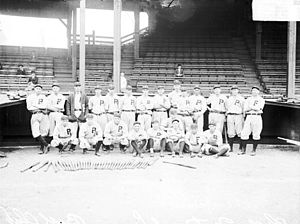
The 1915 Phillies were the first in franchise history to win the National League pennant.
This is a list of seasons completed by the Philadelphia Phillies, originally known as the Philadelphia Quakers, a professional baseball franchise based in Philadelphia, Pennsylvania.
The Philadelphia Phillies have completed 131 seasons in Major League Baseball since their inception in 1883. (Full article...) -
Image 4
Major League Baseball (MLB) annually honors its best relief pitchers in the American League (AL) and National League (NL) with the Mariano Rivera AL Reliever of the Year Award and Trevor Hoffman NL Reliever of the Year Award, respectively. The awards are named after former relievers Mariano Rivera and Trevor Hoffman, who played their entire careers in the respective leagues. First issued in 2014, the awards replaced the Delivery Man of the Year Award, which had been presented since 2005.
The Reliever of the Year Awards are based on the votes of a panel of retired relievers. Each voter selects three pitchers for each league based solely on their performance in the regular season; a 5-3-1 weighted point system is used to determine the winner. At its inception in 2014, the panel consisted of the top five relievers in career saves at the time—Rivera, Hoffman, Lee Smith, John Franco, and Billy Wagner—and the four living relief pitchers who were in the Hall of Fame: Dennis Eckersley, Rollie Fingers, Goose Gossage, and Bruce Sutter. (Full article...) -
Image 5
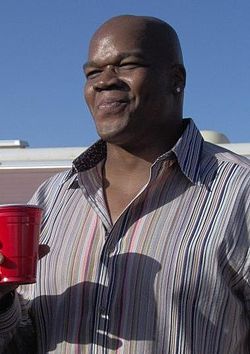
Frank Thomas (1989) was a two-time American League Most Valuable Player, and was a first-ballot Hall of Fame inductee in 2014.
The Chicago White Sox are a Major League Baseball (MLB) franchise based in Chicago, Illinois. They play in the American League Central division. Since the institution of MLB's Rule 4 Draft, the White Sox have selected 66 players in the first round. Officially known as the "First-Year Player Draft", the Rule 4 Draft is MLB's primary mechanism for assigning amateur baseball players from high schools, colleges, and other amateur baseball clubs to its teams. The draft order is determined based on the previous season's standings, with the team possessing the worst record receiving the first pick. In addition, teams which lost free agents in the previous off-season may be awarded compensatory or supplementary picks.
Of the 66 players picked in the first round by the Chicago White Sox, 32 have been pitchers, the most of any position; 20 of them were right-handed, while 12 were left-handed. Twelve outfielders, eight catchers, five shortstops, five third basemen, and four first basemen were also taken. The team has never drafted a player at second base. Fourteen of the players came from high schools or universities in the state of California, and Florida follows with eight players. The White Sox have also drafted six players from their home state of Illinois. (Full article...) -
Image 6The San Francisco Giants are a Major League Baseball team that plays in the National League Western Division. Since their inception as the New York Gothams in 1883, the Giants have employed 37 managers. The duties of the team manager include team strategy and leadership on and off the field.
The franchise's first manager was John Clapp, who managed the team for one year before being replaced in 1884 by Jim Price. The New York Giants won two World Series championships during the 19th century, in 1888 and 1889, with Jim Mutrie as their manager both years.[a] John McGraw became the Giants' manager during the 1902 season, beginning a streak of 54 consecutive years in which the Giants were managed by a Baseball Hall of Famer. McGraw managed for the better course of 30 years (he missed parts of the 1924, 1925, and 1927 seasons due to illness; Hughie Jennings took over for the former two while Rogers Hornsby served as player-manager for the latter), doing so until the middle of the 1932 season, the longest managerial tenure in Giants history. McGraw won 2,583 games as the Giants manager, the most in Giants history. While managing the Giants, the team won the National League championship 10 times—in 1904, 1905, 1911, 1912, 1913, 1917, 1921, 1922, 1923 and 1924. They played in the World Series nine times (no World Series was played in 1904) and won three, in 1905, 1921 and 1922. (Full article...) -
Image 7

Clayton Kershaw holds the Dodgers' record for most Opening Day starts with nine (2011–2018 & 2021).
The Los Angeles Dodgers are a Major League Baseball (MLB) franchise based in Los Angeles. They play in the National League West division. The first game of the new baseball season for a team is played on Opening Day, and being named the Opening Day starter is an honor, which is often given to the player who is expected to lead the pitching staff that season, though there are various strategic reasons why a team's best pitcher might not start on Opening Day. The Dodgers have used 26 different Opening Day starting pitchers in their 67 seasons in Los Angeles. The 26 starters have a combined Opening Day record of 29 wins, 27 losses and 10 no decisions.
The Dodgers started playing in Los Angeles in 1958, after moving from Brooklyn. The first Opening Day game for the Dodgers in Los Angeles was played in San Francisco against the San Francisco Giants on April 15, 1958. California native Don Drysdale was the Dodgers' Opening Day starting pitcher that day, in a game the Dodgers lost 8–0. Dodgers starting pitchers won both of their Opening Day starts in their first home ballpark in Los Angeles, Los Angeles Memorial Coliseum. (Full article...) -
Image 8

Mike Piazza is the all-time leader in Silver Slugger Awards among catchers, winning ten consecutive from 1993 to 2002.
The Silver Slugger Award is awarded annually to the best offensive player at each position in both the American League (AL) and the National League (NL), as determined by the coaches and managers of Major League Baseball (MLB). These voters consider several offensive categories in selecting the winners, including batting average, slugging percentage, and on-base percentage (OBP), in addition to "coaches' and managers' general impressions of a player's overall offensive value." Managers and coaches are not permitted to vote for players on their own team. The Silver Slugger was first awarded in 1980 and is given by Hillerich & Bradsby, the manufacturer of Louisville Slugger bats. The award is a bat-shaped trophy, 3feet (91cm) tall, engraved with the names of each of the winners from the league and plated with sterling silver.
Among catchers, Mike Piazza has won the most Silver Slugger Awards, with ten consecutive wins in the National League between 1993 and 2002; this is the most Silver Sluggers won consecutively by any player in Major League Baseball. In the American League, Iván Rodríguez has won the most Silver Sluggers, with six consecutive wins from 1994 to 1999, and a seventh when he tied with Víctor Martínez in 2004. Lance Parrish won the American League award six times (1980, 1982–1984, 1986, and 1990), and Joe Mauer, Jorge Posada and Salvador Pérez have won it five times; Mauer won in 2006, 2008–2010 and 2013, Posada won in 2000–2003 and 2007, and Pérez won it in 2016, 2018, 2020, 2021 and 2024. Hall of Famer Gary Carter (1981–1983, 1984–1986), Buster Posey (2012, 2014–2015, 2017, 2021), and Brian McCann (2006, 2008–2011) are five-time winners in the National League; McCann also won a sixth Silver Slugger in 2016, but in the American League. Other multiple awardees include Benito Santiago (four wins; 1987–1988, 1990–1991), J. T. Realmuto (three wins; 2018–2019, 2022), Mickey Tettleton (three wins; 1989, 1991–1992) and Carlton Fisk (three wins; 1981, 1985, 1988). William Contreras and Salvador Pérez are the most recent National and American League winners, respectively. (Full article...) -
Image 9

Jake Peavy, the Opening Day starting pitcher 2006–09
The San Diego Padres are an American professional baseball team based in San Diego. The Padres compete in Major League Baseball (MLB) as a member club of the National League (NL) West Division. The Padres first played their home games at San Diego Stadium until 2004, when they moved into Petco Park. The first game of the new baseball season for a team is played on Opening Day, and being named the Opening Day starter is an honor, which is often given to the player who is expected to lead the pitching staff that season, though there are various strategic reasons why a team's best pitcher might not start on Opening Day. The Padres have used 24 different Opening Day starting pitchers in their 42 seasons. The 24 starters have a combined Opening Day record of 15 wins, 14 losses and 13 no decisions. No decisions are only awarded to the starting pitcher if the game is won or lost after the starting pitcher has left the game.
The Padres' first Opening Day starting pitcher was Dick Selma, who received a win against the Houston Astros. Randy Jones, Eric Show and Jake Peavy tie the Padres' record for most Opening Day starts with four. Peavy has the most consecutive Opening Day starts with four (2006–2009). Jones and Andy Benes each have had three consecutive Opening Day starts. Benes has the most consecutive Opening Day losses with three from 1993 to 1995. (Full article...) -
Image 10

In baseball, a run batted in (RBI) is awarded to a batter for each runner who scores as a result of the batter's action, including a hit, fielder's choice, sacrifice fly, sacrifice bunt, catcher's interference, or a walk or hit by pitch with the bases loaded. A batter is also awarded an RBI for scoring himself upon hitting a home run. Sixteen players have batted in at least 10 runs in a single Major League Baseball (MLB) game to date, the most recent being Shohei Ohtani of the Los Angeles Dodgers on September 19, 2024. No player has accomplished the feat more than once in his career and no player has ever recorded more than 12 RBIs in a game. Wilbert Robinson was the first player to record at least 10 RBIs in a single game, driving in 11 runs for the Baltimore Orioles against the St. Louis Browns on June 10, 1892.
As of 2024[update], every team that has had a player achieve the milestone has won the game in which it occurred. These games have resulted in other single-game MLB records being set due to the prodigious offensive performance. Robinson, for example, also amassed seven hits in that same game, setting a new major league record that has since been tied by only one other player. Mark Whiten hit four home runs to complement his 12 RBIs for the St. Louis Cardinals on September 7, 1993, tying the single-game records in both categories. By attaining both milestones, he became one of only two players to hit four home runs and drive in 10 or more runs in the same game, with Scooter Gennett being the other. Tony Lazzeri, Rudy York, and Nomar Garciaparra hit two grand slams during their 10 RBI game, equaling the record for most grand slams in one game. Norm Zauchin has the fewest career RBIs among players who have 10 RBIs in one game with 159, while Alex Rodriguez, with 2,086, drove in more runs than any other player in this group and hit the third most in major league history. (Full article...) -
Image 11

Eddie Guardado, a pitcher for the 1993 Xpress, was called up after 10 starts to make his MLB debut with the Minnesota Twins on June 13, 1993.
The Nashville Xpress Minor League Baseball team played two seasons in Nashville, Tennessee, from 1993 to 1994 as the Double-A affiliate of the Minnesota Twins. In those seasons, a total of 60 players competed in at least one game for the Xpress. The 1993 roster included a total of 35 players, while 38 played for the team in 1994. There were 13 players who were members of the team in both seasons. Of the 60 all-time Xpress players, 22 also played in at least one game for a Major League Baseball (MLB) team during their careers.
After the 1992 baseball season, Charlotte, North Carolina, home of the Double-A Southern League's Charlotte Knights, acquired a Triple-A expansion team in the International League, leaving the Southern League franchise in need of a new home. Larry Schmittou, president of the Triple-A Nashville Sounds, offered Herschel Greer Stadium as a temporary home for the displaced team until owner George Shinn could find a permanent home for his club. Upon the league's approval, the franchise relocated to Nashville and became the Nashville Xpress. In order to accommodate two teams at Greer, the Xpress' games were scheduled for during the Sounds' road trips. (Full article...) -
Image 12

Stephen Strasburg (2009) is considered to be one of the greatest pitching prospects in the history of the draft, and won the 2019 World Series MVP with the Nationals.
The Washington Nationals are a Major League Baseball (MLB) franchise based in Washington, D.C. Prior to 2005, they were known as the Montreal Expos and based in Montreal, Quebec, Canada. The Nationals play in the National League East division. Since the institution of MLB's Rule 4 Draft, the Expos/Nationals have selected 73 players in the first round. Officially known as the "First-Year Player Draft", the Rule 4 Draft is MLB's primary mechanism for assigning amateur baseball players from high schools, colleges, and other amateur baseball clubs to its teams. The draft order is determined based on the previous season's standings, with the team possessing the worst record receiving the first pick. In addition, teams which lost free agents in the previous off-season may be awarded compensatory or supplementary picks. The First-Year Player Draft is unrelated to the 1968 expansion draft in which the Expos initially filled their roster.
Of the 73 players picked in the first round by Montreal or Washington, 38 have been pitchers, the most of any position; 27 of them were right-handed, while 11 were left-handed. Thirteen outfielders, ten shortstops, five third basemen, four catchers, and three first basemen were also taken. The team has never drafted a player at second base. In all, 40 of the players were drafted from high school, 27 from four-year colleges, and four from junior colleges. Eleven of the players came from high schools, universities, or junior colleges in the state of California, and Florida follows with 10 players. They have also drafted two players from Puerto Rico: Josue Estrada (1993) and Hiram Bocachica (1994). (Full article...) -
Image 13

The Philadelphia Phillies are a Major League Baseball (MLB) team based in Philadelphia, Pennsylvania. The Phillies compete in MLB as a member club of the National League (NL) East division. In the franchise's history, the owners and ownership syndicates of the team have employed 11 general managers (GMs) and appointed 15 team presidents. The GM controls player transactions, hiring and firing of the coaching staff, and negotiates with players and agents regarding contracts. The team president is the representative for the owner or the ownership group within the front office and is responsible for overseeing the team's staff, minor league farm system, and scouting.
The longest-tenured general manager is Paul Owens, with 11 years of service to the team in that role, from 1972 to 1983. Owens also served as the team manager in 1972, and from 1983 to 1984. After this time, he served as a team executive until 2003, and was inducted into the Philadelphia Baseball Wall of Fame in recognition of his services. The longest-tenured owner is Bob Carpenter, Jr., who was the team's primary shareholder from 1943 to 1972. He appointed the team's first general manager, Herb Pennock, during his tenure. In combination with his son, Ruly, the Carpenter family owned the Phillies for nearly 50 years (until 1981) until it was sold to Bill Giles, son of former league president Warren Giles. The Phillies are currently overseen by team president, Dave Dombrowski. (Full article...) -
Image 14

Mark Buehrle has made nine Opening Day starts for the Chicago White Sox, including in 2010.
The Chicago White Sox are a Major League Baseball franchise based in Chicago. They play in the American League Central division. The White Sox have used 62 Opening Day starting pitchers since they were established as a Major League team in 1901. The first game of the new baseball season for a team is played on Opening Day, and being named the Opening Day starter is an honor, which is often given to the player who is expected to lead the pitching staff that season, though there are various strategic reasons why a team's best pitcher might not start on Opening Day. The White Sox have a record of 60 wins and 53 losses in their Opening Day games, through the 2013 season.
The White Sox have played in three different home ball parks. They played at South Side Park from 1901 through the middle of 1910, the first Comiskey Park from 1910 through 1990, and have played at the second Comiskey Park, now known as U.S. Cellular Field, since 1991. They had a record of four wins and two losses in Opening Day games at South Side Park, 18 wins and 19 losses at the first Comiskey Park and four wins and one loss at U.S. Cellular Field, for a total home record in Opening Day games of 27 wins and 22 losses. Their record in Opening Day away games is 33 wins and 31 losses. (Full article...) -
Image 15
The All-Star Final Vote was an annual Internet and text message ballot by Major League Baseball (MLB) fans to elect the final player for each team that participates in the Major League Baseball All-Star Game, after all other selections were made and announced. The first 33 players were selected by a combination of procedures. The sponsorship changed annually, but the contest remained similar from year to year. Each league presented a five-man ballot and gave the fans a few days to choose one final All-Star. This process was used from 2002 through 2018. (Full article...)
More did you know
- ... that Baseball Hall of Fame executive Ed Barrow discovered Honus Wagner, converted Babe Ruth into an outfielder, and pioneered the first uniform numbers?
- ... that Matt Cain threw more pitches in his perfect game than any other perfect game pitcher before him?
- ... that Chris Archer pitched USA Baseball's International Performance of the Year in 2010?
- ... that Ross Youngs is the member of the National Baseball Hall of Fame who died at the youngest age?
- ... that Cotton Tierney's great-great-nephew named a website after him that has received over 4 million page views?
Sports portals
Selected picture

| Credit: George Grantham Bain Collection |
John Joseph Evers (July 21, 1883 – March 28, 1947) was a Major League Baseball player and manager. He was elected to the Baseball Hall of Fame by the Veterans Committee in 1946. He was born in Troy, New York. He is famously featured in the poem Baseball's Sad Lexicon along with teammates Joe Tinker and Frank Chance.
Associated Wikimedia
The following Wikimedia Foundation sister projects provide more on this subject:
-
Commons
Free media repository -
Wikibooks
Free textbooks and manuals -
Wikidata
Free knowledge base -
Wikinews
Free-content news -
Wikiquote
Collection of quotations -
Wikisource
Free-content library -
Wikiversity
Free learning tools -
Wiktionary
Dictionary and thesaurus
More portals
- Portals with triaged subpages from June 2018
- All portals with triaged subpages
- Portals with no named maintainer
- Automated article-slideshow portals with 51–100 articles in article list
- Automated article-slideshow portals with 501–1000 articles in article list
- Random portal component with 41–50 available subpages
- Automated article-slideshow portals with 201–500 articles in article list
- Random portal component with 11–15 available subpages
- Random portal component with 21–25 available image subpages





